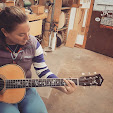 Stringing up an acoustic instrument takes so much longer than I ever think it should. Before you can string a guitar, for example, a shiny Koa 0-42, holes must be drilled through the freshly glued on bridge so that bridge pins can snugly fit into the body of the guitar. I will tell you that holes drilled into an almost finished, shiny, clean guitar is just my least favorite activity. I can definitely feel my blood pressure increase with each turn of the drill bit as it digs deeper into my guitar top. Next, I have to drive little files into those holes to make slots for the strings so they don't bund or cause buzzing under the guitar top. The stressful crux of that operation is keeping the tiny serrated daggers in the slots within bridge holes and keeping them from sneakily popping out and gauging a hole in the top of the beautiful guitar. Lots of times I use one of Herb's bridge removal tools, a piece of cardboard with a bridge shaped hole cut out of it, to keep from hitting the top if I were to slip with the file. Thanks for that invention, Herb.
Stringing up an acoustic instrument takes so much longer than I ever think it should. Before you can string a guitar, for example, a shiny Koa 0-42, holes must be drilled through the freshly glued on bridge so that bridge pins can snugly fit into the body of the guitar. I will tell you that holes drilled into an almost finished, shiny, clean guitar is just my least favorite activity. I can definitely feel my blood pressure increase with each turn of the drill bit as it digs deeper into my guitar top. Next, I have to drive little files into those holes to make slots for the strings so they don't bund or cause buzzing under the guitar top. The stressful crux of that operation is keeping the tiny serrated daggers in the slots within bridge holes and keeping them from sneakily popping out and gauging a hole in the top of the beautiful guitar. Lots of times I use one of Herb's bridge removal tools, a piece of cardboard with a bridge shaped hole cut out of it, to keep from hitting the top if I were to slip with the file. Thanks for that invention, Herb. After the strings are tuned up on the instrument, it has to make the right sounds. If I cut the slots wrong into the fingerboard, that won't be the case. So far, that hasn't happened to one of my instruments, as I am severely meticulous when it comes to making fingerboards, due to this exact reason, but I always check every note anyway. After making sure each note is correct on the fingerboard, it is time to check for buzzing. In order to reduce the chance of the strings buzzing, all of the frets must be even so that the strings hit at the right spot on the fingerboard rather than hitting a high fret closer to the soundhole. Now that we have a fret press rather than having to hammer each fret into the fingerboard slot, the job of filing the frets even with each other is significantly easier. When I would hammer the metal, it would never end up even across the fingerboard, leaving little humps on each fret to be filed down. Even though it is a bit simpler, I still look at the arced piece of metal onto which a strip of sand paper is affixed with disdain as it is never a fun task to scrub it across the fingerboard of a finished guitar.
The thing about all the extra work that comes with finishing a guitar or a ukulele is that I feel even more attached to this thing that I have made, a lot of times feeling as though it is a living being I am adopting out, hopefully to a loving home. And I worry with each one that it won't go to as loving a home as I would wish. That is typically not the case at all, as most folks who order a custom instrument know how to care for and love what I have painstakingly made. This time was no exception. I can tell just as the case is first opened when someone really understands what I want for one of my guitars, and I think my latest 0-42 is going to be a very happy guitar. It's new owner Roger's face lit up almost as much as Ralphie's did when he received his Official Red Ryder Carbine-Action Two Hundred Shot Range Model Air Rifle. Hopefully Roger doesn't put his eye out with his new guitar though. I am usually so sad to see all of my hard work head out the door, but this time I was so happy to experience how glad it's new owner was to have it, and I know it will be well loved and have a great life.










